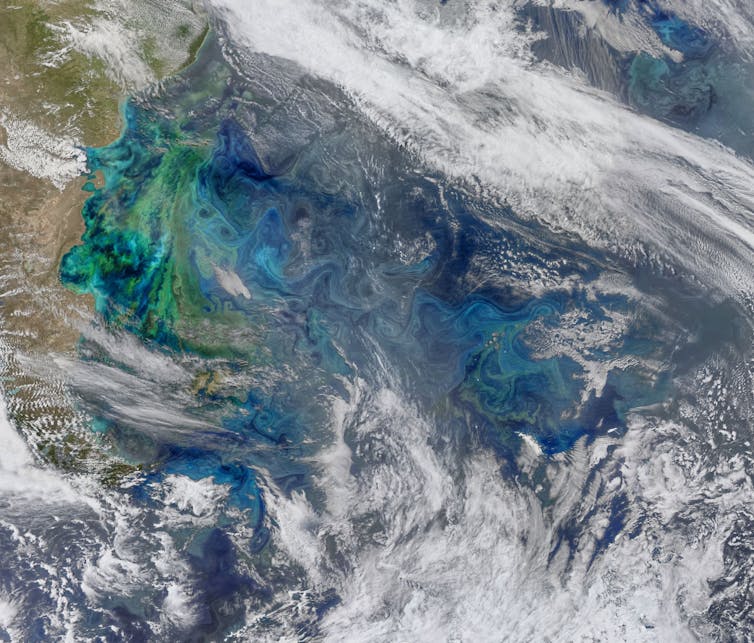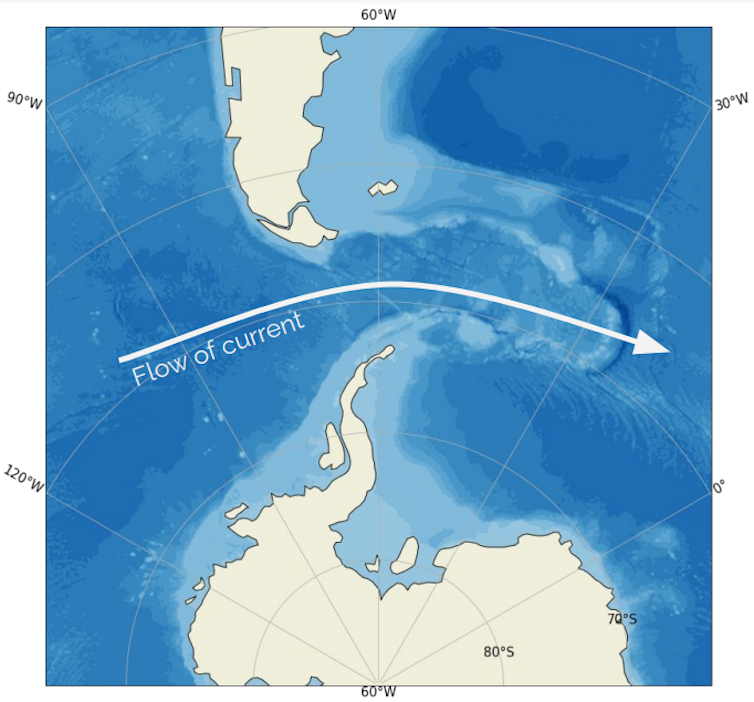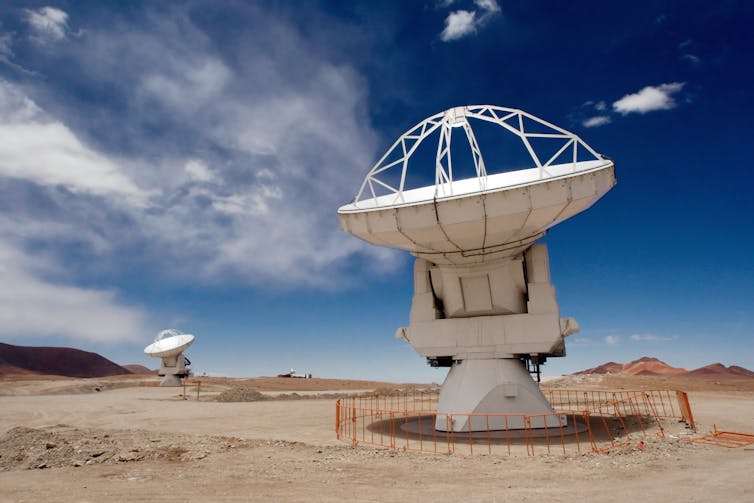In the turbulent Drake Passage, scientists find a rare window where carbon sinks quickly into the deep ocean
Looking out across the Southern Ocean near Antarctica, I can see whales and seabirds diving in and out of the water as they feed on sea life in the lower levels of the food web

Estimated reading time: 9 minutes
Lilian (Lily) Dove, California Institute of Technology
At the base of this food web are tiny phytoplankton – algae that grow at the ocean surface, taking up carbon from the atmosphere through photosynthesis, just as plants on land do.
Because of their small size, phytoplankton are at the mercy of the ocean’s swirling motions. They are also so abundant that the green swirls are often visible from space.
Typically, phytoplankton remain near the surface of the ocean. Some may slowly sink to depth because of gravity. But in the turbulent Drake Passage, a 520-mile-wide (850 km) bottleneck between Antarctica and South America, something unusual is happening, and it has an impact on how the ocean takes carbon dioxide – the main driver of global warming – out of the atmosphere.
The Drake Passage
The Drake Passage is notorious for its violent seas, with waves that can top 40 feet (12 meters) and powerful converging currents, some flowing as fast as 150 million cubic meters per second. Cold water from the Southern Ocean and warmer water from the north collide here, spinning off powerful and energetic eddies.
New scientific research I am involved in as an oceanographer now shows how the Drake Passage and a few other specific areas of the Southern Ocean play an outsize role in how the oceans lock up carbon from the atmosphere.

That process is crucial for our understanding of the climate. The global ocean is a massive reservoir of carbon, holding over 50 times as much carbon as the atmosphere. However, it is only when water carrying carbon gets to the deep ocean that carbon can be stored for long periods – up to centuries or millennia.
Photosynthetic phytoplankton are at the heart of that exchange. And in the Drake Passage, my colleagues and I have found that undersea mountains are stirring things up.
The role of ocean layers
The ocean can be visualized as having layers. With constant surface waves and winds, the upper layer is always stirring around, mixing waters. It’s like mixing milk into your morning coffee. This stirring mixes in solar heat and gases, such as carbon dioxide, taken up from the atmosphere.
Water density generally increases as the waters get deeper and colder and saltier. That forms density layers that are typically flat. Since water prefers to keep its density constant, it mostly moves horizontally and doesn’t easily move between the surface and deep ocean.
Yet despite this physical barrier, water testing shows that carbon dioxide produced by human activities is making its way into the deep ocean. One way is through chemistry: Carbon dioxide dissolves in water, creating carbonic acid. Living creatures in the ocean are another.
A view into the Drake Passage
Oceanographers have long pointed to the north Atlantic Ocean and the Southern Ocean as places where surface waters are moved to depth, taking large volumes of carbon with them. However, recent work has shown that this process may actually be dominated by only a few areas – including the Drake Passage.
Despite its being one of the most famous stretches of the ocean, scientists have only recently been able to observe this window in action.
The main flow of the Drake Passage is created by the effect of strong westerly winds across the Southern Ocean. Scientists have found that the westerly winds create a slope in the water density, with dense waters shallower closer to Antarctica, where colder melt water caps the surface, but sloping deeper into the ocean farther north toward South America.
With advances in autonomous underwater robots and computer modeling, we have been able to show how the flow of the Southern Ocean interacts with an underwater mountain in the Drake Passage. This underwater interaction mixes up the ocean, enhancing that coffeelike stirring process.
The stirring along the sloped density levels provides a pathway for water from the upper layer of the ocean to move into the depths. And phytoplankton at the surface ocean are carried along with this stirring, moving to depth much faster than they would by gravitational sinking alone.
In a less energetic region, these phytoplankton would die and respire their carbon back to the atmosphere or slowly sink. However, at the Drake Passage, phytoplankton can be swept to depth before this happens, meaning the carbon they’ve taken up from the atmosphere is sequestered in the deep ocean. Carbon dissolved and stored in the deep ocean may also vent out in these locations.
Scientists have estimated that the deepest ocean waters directly interact with the atmosphere through only about 5% of the ocean’s surface area. This is one of those special places.
Investigating the Drake Passage and other oceanographic windows allows science to home in on better understanding climate change and the workings of our blue planet.![]()
Lilian (Lily) Dove, Ph.D. Candidate in Oceanography, California Institute of Technology
This article is republished from The Conversation under a Creative Commons license. Read the original article.
What's Your Reaction?
























